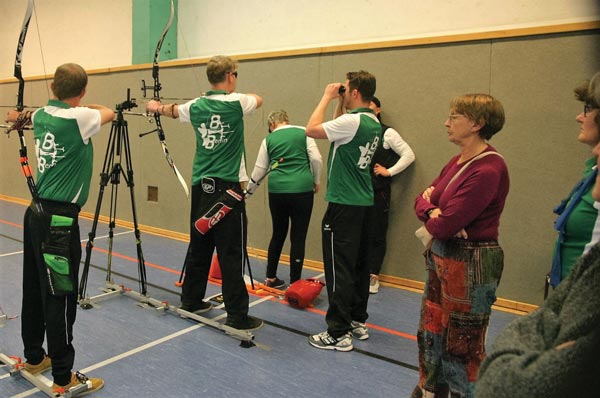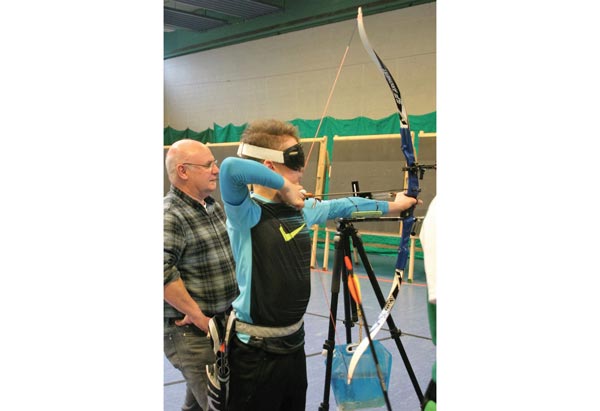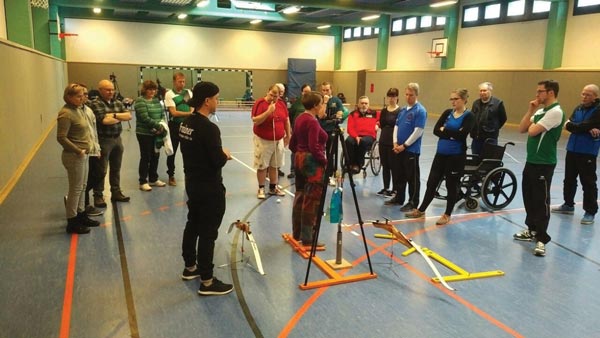Sue Habgood has taken the quest for greater participation in VI archery to the continent

For many years Sue was Development Officer for British Blind Sport and travelled the country with colleagues introducing and coaching archers of all abilities
Sue Habgood is a county coach based in Sussex that has been involved in VI (visually impaired) archery for a number of years. She’s seen a sizeable development in that time, but says there’s still a long way to go before it’s accessible by VI archers everywhere.
“I started as a volunteer at Blind Veterans UK, formerly St Dunstans, and have worked with archers with visual impairments from total blindness to those that have varying degrees of sight loss,” she explains. “With the assistance of archers and other coaches a tactile sight system has been produced, which enables VI archers to compete alongside other archers in competitions. For many years I was Development Officer for British Blind Sport and travelled the country with colleagues introducing and coaching archers of all abilities.”
More recently, she was invited to BSC BB-Berlin in Germany to give a presentation on VI archery, which comprised of a competition for archers of varying abilities and a seminar the day after, explaining the techniques used to introduce archers to the tactile aiming system. “The aim of the weekend was to raise awareness of archery for the visually impaired alongside archers with other disabilities,” Sue explains, “It was lovely to see a range of abilities from Olympic standard to beginners. Everyone enjoyed themselves and I was able to observe actions and reactions throughout the day.

BBS has worked hard to get VI archery recognised for the Paralympics but there are not enough archers worldwide to move things forward
“On the Sunday I gave my presentation. My knowledge of German is very limited and I was very grateful for the fact that most of those present, which included archers, coaches, supporters and family members, could speak and understand English. I have to thank Gaby for her translator abilities and was pleased that in some cases actions were enough to create an understanding of what I wanted to demonstrate. I explained the coaching methods used to assist VI archers to shoot well, and that the same principles of correct stance and shooting action applied to VI archers and the importance of a good style before the tactile equipment was introduced.
“There was great interest from the participants and all the coaches, and some archers tried out the tactile system and plenty of questions were asked. I was very pleased that Sebastian, a young lad who is losing his sight, took to using the tactile equipment and spent the afternoon shooting very well. Thomas and Carsten are VI archers and were able to show how consistent their shooting was using the equipment.
“It was a pleasure talking to Alex, the coach, about how we operated and explaining some of the history of VI archery and how we came to use the system we have today.”

What is needed is more awareness that archery is a sport for all, from the grass roots to competitive archery
Despite the positives, Sue says there is still plenty of room to increase both VI participation and access. “I learnt from Alex and Gaby how hard it is to interest visually impaired people to try something different,” she says, “It is the same in the UK. The sport needs more archers with visual impairments and other disabilities to show what can be achieved. I learnt from the visit that there was a willingness to assist archers with all kinds of disabilities but, as in Great Britain, there are not many VI archers. The club had worked hard to maximise interest and will continue to do so, but it is hard to motivate people. I know from my experience that people will come and try archery for a day out, but have no wish to continue – the lack of money and motivation plays its part.
“BBS has worked hard to get VI archery recognised for the Paralympics but there are not enough archers worldwide to move things forward. I have done seminars for coaches, and there may be opportunities for others to be presented. What is needed is more awareness that archery is a sport for all, from the grass roots to competitive archery.”
How it works: tactile sight
The foot locators are positioned on the shooting line so that the archer is in line with the target.
The tripod and tactile sight is set so that when the archer raises their arm the back of the hand lightly touches the sight. This takes the place of a sight ring and can be moved according to the distance required.
If you fancy giving VI archery a boost in your area, get in touch with British Blind Sport to find out about the volunteering opportunities at secretary@bbsarchery.org.uk
This article originally appeared in the issue 122 of Bow International magazine. For more great content like this, subscribe today at our secure online store: www.myfavouritemagazines.co.uk


Please could you help set up a VI archery club at New College Worcester for children who are blind or visually impaired. I’m a parent of a student there, he’s 17 and is a member of his local club in Devon and the school would love an archery club to be formed or visit the school. Please can you help?
I work for an Adaptive Sports Program in Phoenix, AZ, USA. We have a number of participants who have VI and are interested in archery but I don’t have a tactile sight. Do you have any resources for obtaining 1 or 2? Or making any? Thank you for your time.
Josh Parks, CTRS, CARSS-II